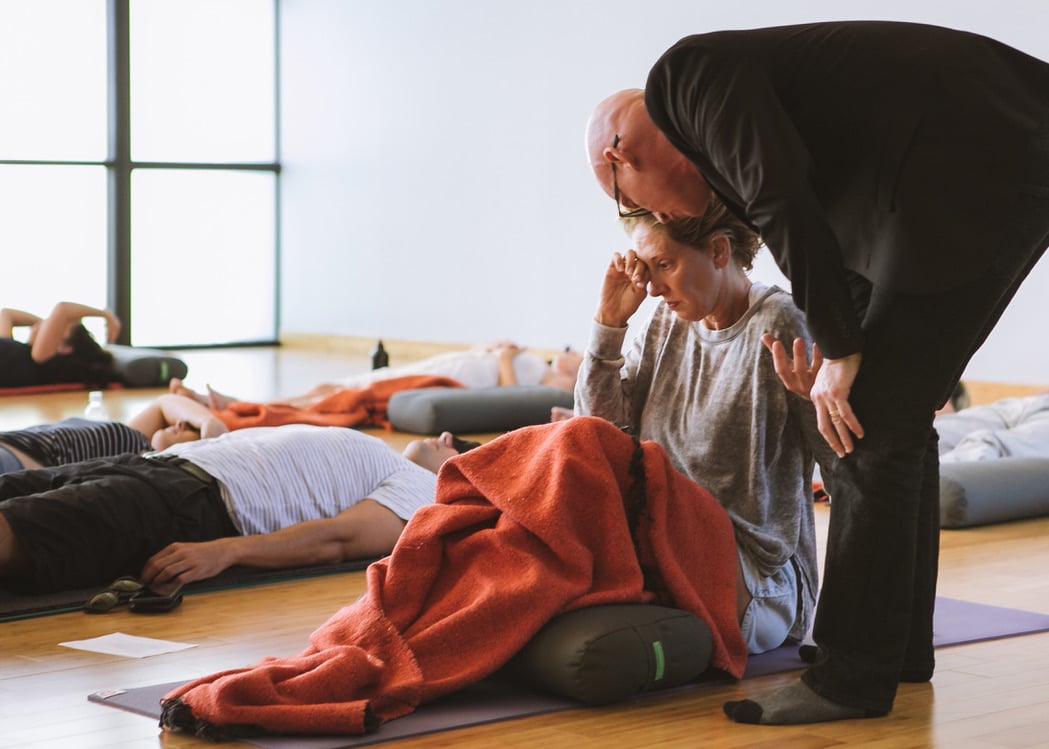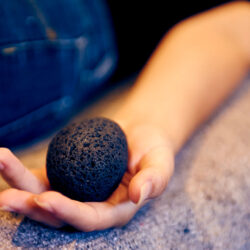There’s a lot of talk about healing trauma these days. And with so many tools and options out there, it’s easy to get overwhelmed or wary (especially with so much woo-woo stuff on the internet).
By the time most people take an interest in breathwork, they’ve tried a lot of stuff already. Meditation, yoga, therapy, and maybe even mood medication. By the way, these are valid ways to handle trauma. There’s no one-size-fits-all solution to healing a painful past.
That being said, breathwork stands out in this kind of work. Not only can it release trauma, but it is the single best tool I’ve ever discovered to do so.
It’s not another new-age airy-fairy notion some hippie cooked up to go viral on TikTok. Breathwork has been around for thousands of years. People have been using the technique to heal before even knowing what trauma is. There is a deeper wisdom within us, showing us what to do even if we can’t verbalize it.
Science has only started to examine breathwork for trauma in recent years. There are some studies that show the technique is a transformational tool – however, breathwork research is still in its early stages.
Here’s the thing though: I don’t need studies to tell me what I already know. It’s my experience that breathwork can release massive amounts of trauma and jumpstart the healing process.
And it’s not just me. Over the last decade, I’ve watched thousands of people heal their trauma through breathwork. I’ve seen lives restored after years of chasing shadows and trying virtually everything to get better. You can’t make this stuff up.
I’d like to share my personal story here so you can see for yourself how much power lies in this practice.
My Story: How Breathwork Changed My Life
There were obvious traumas that I had suffered but never dealt with.
For example, at the age of 19 I was stabbed in the head left for dead. I lost a lot of blood and couldn’t find help. I knocked door after door, begging people to help me. No one would open the door. Finally, I asked someone just to call an ambulance as I lay on the curb bleeding out, wondering if I was going to live to see my 20th birthday.
I passed out from loss of blood and ended up getting 41 stitches in my head with no anesthetic. The plastic surgeon was stitching my head with special bifocal goggles on his eyes and he said to me; “don’t worry kid, your hair will cover it.”
Little did he know, a few years later I would be diagnosed with alopecia and lose all of my hair. So the joke’s on him.
The trauma didn’t stop there.
I was beaten up by four guys in their 20s when I was 16 years old. I was knocked unconscious and got suffered a concussion when my head hit the pavement. While I was unconscious, these four guys kicked me. I ended up in the hospital.
To say I didn’t feel safe in the world is an understatement.
The message I received from these incidents is that people can hurt you and get away with it without consequences.
Albert Einstein once said, “The most important decision we make is whether we believe we live in a friendly or a hostile universe.” As he noted, that’s a decision each individual makes, and it influences everything about how we approach the world. There was no question of which world I was living in.
What type of world do you think you’re going to create and live in if you feel like you live in a hostile universe?
Breathwork was the only thing I found that enabled me to change my perspective. It switched my worldview from hostile to friendly.
I don’t know of anything else that can reset your worldview. If you do, please tell me about it.
As I mentioned, I experienced some traumas that were obvious to me. But there were so many others that I had “forgotten” – or more likely just locked away deep inside.
When I did breathwork for the first time, something completely unexpected happened. All those “forgotten” traumas came flooding back to me, and some of them weren’t obvious right away.
I kept experiencing this strange feeling in the middle of my right forearm. It took a few sessions before I remembered that it was from when I broke my arm when I was nine. During the session in which I experienced that realization, I forgave the nine-year-old version of myself for being so careless.
Most of my breathwork journey has been about self-love, self-forgiveness, and releasing shame and guilt.
We are so hard on ourselves. One of the great realizations I’ve experienced from breathwork is that I will continue making mistakes. Yes, even if I strive to do my absolute best. There’s no way around it. It’s part of being human. However, I don’t have to continue to beat myself about it!
If you can make the shift and be a kinder, more compassionate person to yourself, this will enable you to exhibit more compassion toward others – and will change the world around you.
How Does A Person Get Traumatized?
We accumulate trauma through our experiences, especially during our formative years. Childhood trauma is like “programming,” and even as adults, it still influences us. We even become slaves to our trauma. On top of that, we can develop deep scarring from traumatizing events throughout our lives.
According to Bethany L. Brand and Shaina A. Kumar1, the most common types of trauma are the following:
- Child Maltreatment/Neglect
- Domestic Violence
- War Related Trauma
- Medical Trauma
- Traumatic Loss
- Natural Disasters
- Sexual Assault.
Sometimes trauma is suppressed deep inside us, and we’re able to function just fine – until the trauma reappears (and it always does).
Other times, deep trauma can cause symptoms such as appearing shaken or disoriented, or being unable to respond to conversation in a normal way. Traumatized people may also appear withdrawn or not fully present in the moment, even when speaking.
One of the most common symptoms of trauma is anxiety.
Severe anxiety from trauma can manifest itself through edginess, night terrors, poor concentration, mood swings, or even disorientation. Trauma also may not be immediately noticeable. It can take days, months, or even years to fully manifest into outwardly noticeable symptoms.
One thing that’s really important to remember is that trauma doesn’t just live in the mind. Trauma gets stored in the body and can manifest in different ways:
- Physical sensations such as tension, pain, numbness, and tingling. These sensations can persist long after the traumatic event has passed.
- Emotions such as fear, anger, shame, and helplessness. These emotions can become trapped in the body and continue to influence a person’s thoughts, feelings, and behaviors. They can also cause nightmares or sleep-related disturbances, which we are far more vulnerable to at night.
- Changes in the brain by altering a person’s perception of themselves and the world around them – the friendly vs. hostile environment idea I mentioned earlier. A traumatized person will feel unsafe even in the safest, most loving environments.
- Behavior changes to cope with the trauma, such as substance abuse, self-harm, or disordered eating. This leads to a vicious cycle where shame and guilt lead to even more self-destructive, traumatizing behavior.
I’m not going down the rabbit hole with this. There are MANY books on the topic of trauma. If you’re interested in learning more about trauma and the body, I recommend The Body Keeps the Score by Bessel van der Kolk.
How Does Breathwork Release Trauma?

Most of my students say breathwork feels like “20 years of therapy without all the talking.” Breathwork helps release trauma from the body in various ways:
- By tapping into the sympathetic nervous system – It’s my personal belief that trauma gets stored in our sympathetic nervous system (sympathetic = fight or flight; parasympathetic = rest and digest). This is part of the reason I believe that circular breathwork through the mouth is so powerful for healing trauma. Because when we breathe through the mouth, we’re breathing into our sympathetic nervous system.
You might ask “When I exercise intensely, I breathe through my mouth. Why aren’t my traumas coming up at that time?”
One theory I have is that when we’re exercising intensely, we are using the oxygen in our muscles for physical exercise. When we’re lying still and breathing into the sympathetic nervous system, something different happens.
Animals have a mechanism for clearing trauma. For example, when a rabbit gets chased by a predator but then escapes, it shakes itself to relieve the trauma. I believe breathwork could be our own mechanism to self-regulate.
- By releasing tension in the body – Trauma can make you tense up without even knowing it. You can experience pain in the back, neck, or shoulders without any injuries. Breathwork can help release tension in your muscles by increasing blood flow and releasing endorphins. Also, when you reduce stress in the present moment by breathing deeply, emotional aches and pains tend to get better.
- By blocking your inner critic – The voice that makes you feel like a loser at every opportunity. When we practice breathwork, the self-critical part of our brains temporarily shuts up. The result? Feelings start coming out, because the censorship is no longer there. You may find yourself crying out all the stuff you’ve kept buried inside. You may shake or laugh. It doesn’t matter. The important thing is you’re letting it out. That’s the only way to process emotions. You can’t think them away. You have to FEEL them.
After participating in breathwork classes, many people experience enhanced creativity, a massive reduction in tension, and a general sense of well-being.
This can also help by bringing the mind and body back into alignment and making it easier to deal with past trauma. Almost all types of breathwork are done with the intention to alter one’s state of consciousness, enabling the person to gain insight into their problems.
What’s The Science Behind Breathwork And Trauma?
Breathwork has been around for thousands of years, yet science is just beginning to show interest. And the technique may never get the attention it deserves!
As I said before, I know it’s transformative. And thousands of people I’ve personally guided also know this.
But for the science-minded among us, there are some studies that link breathwork to trauma release:
- A study published in 20052 investigates how certain breathing exercises might help reduce stress, anxiety, and depression by examining how the brain and nervous system are involved. The study does not directly focus on trauma but rather on the effects breathwork has on stress, anxiety, and depression. Factors that are often related to trauma. The authors suggest that practicing certain breathing techniques can have positive effects on the brain and body, which may help improve emotional well-being.
- A study published in 20103 investigated if practicing specific breathing exercises could help people who experienced trauma and depression following the 2004 tsunami disaster in Southeast Asia. The study found that the groups who received the yoga breath intervention showed significant improvements in PTSD and depression symptoms compared to the control group. This suggests that breathing exercises can be helpful for people dealing with trauma and depression.
- Another study published in 20144 investigated whether breathing exercises could help military veterans who were struggling with PTSD symptoms. It found that the group who participated in the breathing program experienced significant reductions in PTSD symptoms compared to the control group. Furthermore, the improvements in PTSD symptoms were maintained over time, suggesting that breathing-based meditation can be beneficial for individuals with PTSD, at least in the population studied (U.S. military veterans).
- Finally, a study published in 20145 investigated if practicing yoga, which includes breathwork and physical postures, could help people who were struggling with PTSD symptoms. The researchers wanted to determine if adding yoga to the existing treatment plan would be more effective than just receiving the usual care. The study found that participants who participated in the yoga intervention experienced significantly greater reductions in PTSD symptoms compared to those in the control group. By the end of the study, 52% of the yoga group participants no longer met the criteria for PTSD, compared to 21% in the control group. This suggests that yoga, which incorporates breathwork, can be a helpful addition to PTSD treatment.
While there are no specific studies related to circular connected breathing (the technique I teach), these studies suggest that breathing exercises can help with anxiety, stress, depression, and trauma.
What Is Trauma-Informed Breathwork Training?
“Trauma-Informed Breathwork Training” is the catchphrase these days. For me, breathwork training is all about preparing teachers for dealing with their students’ trauma. Otherwise, you’re just showing a simple technique and there’s not much training needed.
“Trauma-Informed Breathwork Training” is like saying “I’m a German Shepherd” and “I’m also a dog.” It’s implied.
When I first started teaching this particular circular breathwork technique online, some veteran teachers said it was dangerous to do teach remotely.
When I asked them why, no one could give me an answer. Ironically, when the pandemic lockdown happened, virtually all instructors started teaching breathwork online.
I felt like my personal experience had shown me something different.
I knew I could do it online because I had processed my own trauma in my room by myself – not at an in-person session or live class.
It would’ve been nice to have someone online guiding me. I also believe that someone with trauma may be more comfortable alone rather than in a room with a people nearby. Or worse, with a breathwork teacher (or helper) putting their hands all over them during breathwork to show them the correct technique. This is especially true for people who have experienced sexual abuse trauma.
There are facilitators who use a lot of touch during the breathwork session. I use some but ONLY with permission from the client first and only lightly touching certain areas (belly, feet, shoulders).
I do however think it’s better (if a client has experienced certain physical traumas, such as sexual abuse) for the breathwork facilitator/teacher NOT to touch the client and even sit farther away from the client – providing them with a safer feeling space. This is just one of the many reasons I love online breathwork sessions and classes.
Is Breathwork Right For Me?
Yes. No matter what your life looks like, you have trauma. It’s unavoidable. The very moment we enter this world is in itself traumatizing.
As we grow up, parents will traumatize us – it doesn’t take addiction, violence, or neglect to do that. Parents may try their best but still leave us with bad “programming” that follows us throughout our entire lives.
Then think of all the heartbreak and pain we each carry around. This is all part of the human experience. Without pain, we wouldn’t be able to live the full spectrum of emotions life comes with. We need it, but we also need to learn how to process pain and move on.
And this is what breathwork can do for you. It can help you begin to process all the stuff you’ve tucked away from the world and from yourself. It’s the most liberating thing you can do.
Breathwork will help you experience tremendous growth in your physical, mental, and emotional state. It will help you break free from bad habits and create new healthier ones.
Here’s what you need to know to change your life:
If you want results, you need to make the effort. No one is coming to save you. And nothing changes if nothing changes.
If you want something different, then do something different.
I will show you exactly how and what to do. No BS. I’ll show you how to change your life immediately, take the simple steps that are necessary and create lasting and transformative change. All you have to do is show up!
1Brand, B. L., & Kumar, S. A. (n.d.). What are major types of trauma? Teach Trauma. Retrieved from https://teachtrauma.com/information-about-trauma/types-of-trauma/
2Brown, R. P., & Gerbarg, P. L. (2005). Sudarshan Kriya yogic breathing in the treatment of stress, anxiety, and depression: Part I-neurophysiologic model. The Journal of Alternative and Complementary Medicine, 11(1), 189-201. https://pubmed.ncbi.nlm.nih.gov/15750381/
DOI: 10.1089/acm.2005.11.189
3Descilo, T., Vedamurtachar, A., Gerbarg, P. L., Nagaraja, D., Gangadhar, B. N., Damodaran, B., … & Brown, R. P. (2010). Effects of a yoga breath intervention alone and in combination with an exposure therapy for post-traumatic stress disorder and depression in survivors of the 2004 South-East Asia tsunami. Acta Psychiatrica Scandinavica, 121(4), 289-300. https://pubmed.ncbi.nlm.nih.gov/19694633/
DOI: 10.1111/j.1600-0447.2009.01466.x
4Seppälä, E. M., Nitschke, J. B., Tudorascu, D. L., Hayes, A., Goldstein, M. R., Nguyen, D. T., … & Davidson, R. J. (2014). Breathing-based meditation decreases posttraumatic stress disorder symptoms in US military veterans: a randomized controlled longitudinal study. Journal of Traumatic Stress, 27(4), 397-405. https://www.ncbi.nlm.nih.gov/pmc/articles/PMC4309518/
doi: 10.1002/jts.21936
5 van der Kolk, B. A., Stone, L., West, J., Rhodes, A., Emerson, D., Suvak, M., & Spinazzola, J. (2014). Yoga as an adjunctive treatment for posttraumatic stress disorder: a randomized controlled trial. The Journal of Clinical Psychiatry, 75(6), e559-e565. https://pubmed.ncbi.nlm.nih.gov/25004196/
DOI: 10.4088/JCP.13m08561




